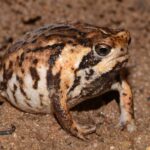Discovering Arthroleptis lameerei: The Enigmatic Rainforest Frog of Central Africa#
Beneath the dense canopy of Central Africa’s lush tropical rainforests, where shadows play gracefully over damp leaf litter and the humid air buzzes with life, lives a small yet captivating inhabitant—Arthroleptis lameerei. Known affectionately among herpetologists and enthusiasts as Lameere’s squeaker frog, this elusive creature embodies the subtle charm of rainforest amphibians, thriving unnoticed amidst the rich tapestry of biodiversity.
Despite its modest size and understated appearance, Arthroleptis lameerei encapsulates a profound story of adaptation, ecological importance, and the delicate balance that governs our natural world. Equally notable is its mysterious nature; even scientists acknowledge much remains unexplored about this intriguing amphibian species. Let’s embark together into its fascinating world and learn more about the life, behavior, and conservation challenges faced by this enigmatic rainforest frog.
Taxonomy and Classification#
Arthroleptis lameerei belongs to the family Arthroleptidae, a diverse group of small, ground-dwelling frogs primarily distributed across Africa’s tropical regions. Within this family, frogs commonly termed as “squeakers” or “litter frogs” display fascinating behaviors and physiological adaptations uniquely suited to a terrestrial existence. Scientifically classified as follows:
- Kingdom: Animalia
- Phylum: Chordata
- Class: Amphibia
- Order: Anura
- Family: Arthroleptidae
- Genus: Arthroleptis
- Species: Arthroleptis lameerei
Within its genus, Arthroleptis lameerei shares close evolutionary links with other litter-dwelling frogs, known collectively for their cryptic coloration and discrete habits. These frogs provide valuable insight into species diversification processes occurring in tropical rainforests, making them ecological and evolutionary treasures.
Natural Habitat#
Geographical Range and Distribution#
The habitat range of Arthroleptis lameerei spans a specific region in Central Africa, notably within countries like the Democratic Republic of Congo and Uganda. These dense forests offer a highly specialized microhabitat, representing complex ecosystems that have evolved over millions of years. Amid these habitats, Arthroleptis frogs roam quietly under blankets of leaf litter, barely noticeable due to their exceptional camouflage and diminutive size.
This secretive rainforest species favours the moisture-rich forest floors, an environment filled with decomposing organic material, moss-covered logs, and endlessly diverse invertebrate life. As voracious insect predators, these frogs rely on the abundant biodiversity within such microhabitats, playing a pivotal role in regulating the delicate food webs of the rainforest floor.
Microhabitat Preference#
Lameere’s squeaker frog shows a profound preference towards humid, shadowy microhabitats, regularly found near slow-flowing streams, damp leaf litter accumulations, or hidden discreetly under logs. Maintaining stable humidity levels is crucial, as their skin remains highly permeable, absorbing moisture and oxygen directly from their surroundings. The stability of these ecological niches protects them from extreme temperature fluctuations, providing ideal conditions critical for their survival and reproduction.
Physical Characteristics#
A closer look at Arthroleptis lameerei reveals a delicate array of features perfectly adapted to its rainforest existence. With adult frogs typically measuring around 25-30 millimeters in length, their compact body proportions allow swift navigation through narrow forest openings, beneath piles of vegetation, and within small crevices.
Coloration is primarily cryptic—shades vary subtly from reddish-brown to darker shades of gray and brown, accented with irregular darker patterns sprinkled generously along their dorsal surface. Their skin texture ranges from smooth to slightly grainy, providing further camouflage amid the moist, dark forest floor. Their limbs, though slender, are muscular, affording them quick leaps if startled or confronted by potential threats.
Perhaps most intriguing are their eyes—large, expressive, and protruding, uniquely adapted to low-light environments. These highly sensitive visual organs allow the frog to identify both prey and predators efficiently in dim conditions beneath the dense rainforest canopy.
Behavior and Life Cycle#
Feeding Habits#
Arthroleptis lameerei holds the quiet reputation of a night-time predator—emerging from daytime shelters during twilight hours as darkness cloaks the rainforest in mystery. Their diet primarily consists of small invertebrates, including ants, termites, spiders, beetles, and small arthropods abundant in the forest floor layers. Using stealth and precise movements, they seize prey swiftly, adapted meticulously to exploit minute variations within their highly competitive microhabitats.
Breeding and Reproduction#
Lameere’s squeaker frog displays a fascinating reproductive strategy differentiated from many other amphibians. Notably, members of the genus Arthroleptis typically exhibit direct development, whereby eggs deposited amid damp leaf litter hatch directly into miniature froglets, bypassing the vulnerable aquatic tadpole stage entirely. While scientists continue to study specific details of reproduction in A. lameerei, they assume similar strategies given patterns observed among closely related frogs.
Unique Vocalizations and Communication#
True to their common name, “squeaker frogs,” these amphibians produce characteristic high-pitched vocalizations—subtle yet resonant calls echoing through humid forest evenings. Males vocalize to attract mates and ward off rivals. Often emitting short, melodious “squeaks” repeated rhythmically, their calls form part of the greater symphony composed by nocturnal rainforest creatures. To naturalists exploring the jungle, these subtle sounds spark curiosity, signaling the presence of these elusive frogs deep within leafy shelters.
Ecological Role#
While modest in size and demeanor, the role of Arthroleptis lameerei within its ecosystem is nothing short of essential. As effective insect termites and drivers of nutrient recycling, these frogs help maintain rainforest health by controlling local insect populations. Conversely, they become prey themselves, providing sustenance to snakes, birds, and larger amphibians, forming integral components of complex rainforest food web structures.
In scientific terms, squeaker frogs serve as vital ecological indicators. Shifts in their population density and distribution can signal environmental changes, alerting ecologists and conservationists early when anthropogenic threats or climate shifts emerge to endanger rainforest ecosystems.
Threats and Conservation Status#
Unfortunately, much like many other rainforest-dwelling amphibians worldwide, Arthroleptis lameerei faces increasing threats due to habitat loss, deforestation, and environmental degradation. Logging operations, agricultural expansion, and human settlements shrink pristine forest areas, isolating frog populations and disrupting essential microhabitats. Climate change, too, poses grave risks by altering rainfall patterns, humidity levels, and temperatures crucial to their survival.
Currently, Arthroleptis lameerei remains insufficiently studied, and accurate population assessments are lacking. Researchers urge intensified monitoring efforts and increased funding toward exploring their biology and habitat dynamics further. Robust scientific research combined with localized conservation measures promises the best avenue for safeguarding this enigmatic species.
Cultural and Scientific Significance#
Although relatively unknown in popular culture, frogs such as Arthroleptis lameerei hold profound symbolic meaning across many indigenous communities. In many traditional beliefs throughout Central Africa, frogs represent fertility, renewal, and harmony with nature—an homage to the amphibians’ sensitivities and adaptability in the face of environmental changes.
Scientifically, squeaker frogs continue to attract attention from biologists attempting to decode secrets of evolutionary biology, ecology, and emerging biomedical discoveries. Studies on terrestrial amphibians yield insights into skin compounds, genetics, and disease patterns, informing strategies for conservation and human health alike.
Conclusion#
The delicate existence of Arthroleptis lameerei amidst Central Africa’s rainforest is both a symbol and reminder of interconnected ecological relationships upon which our planet’s biodiversity depends. By advocating conservation efforts, encouraging scientific research, and growing awareness about these miniature rainforest ambassadors, we not only extend protection directly towards this remarkable species but also safeguard the countless beings that thrive alongside them.
As admirers of wildlife, each of us bears responsibility in appreciating and protecting species like Lameere’s squeaker frog. Explore, learn, share, and participate actively in conservation. Our natural heritage, thriving ecosystems, and future generations depend upon our mindful stewardship today.










